Course Registration.
VerifiedAdded on 2023/01/05
|17
|2633
|56
AI Summary
Contribute Materials
Your contribution can guide someone’s learning journey. Share your
documents today.
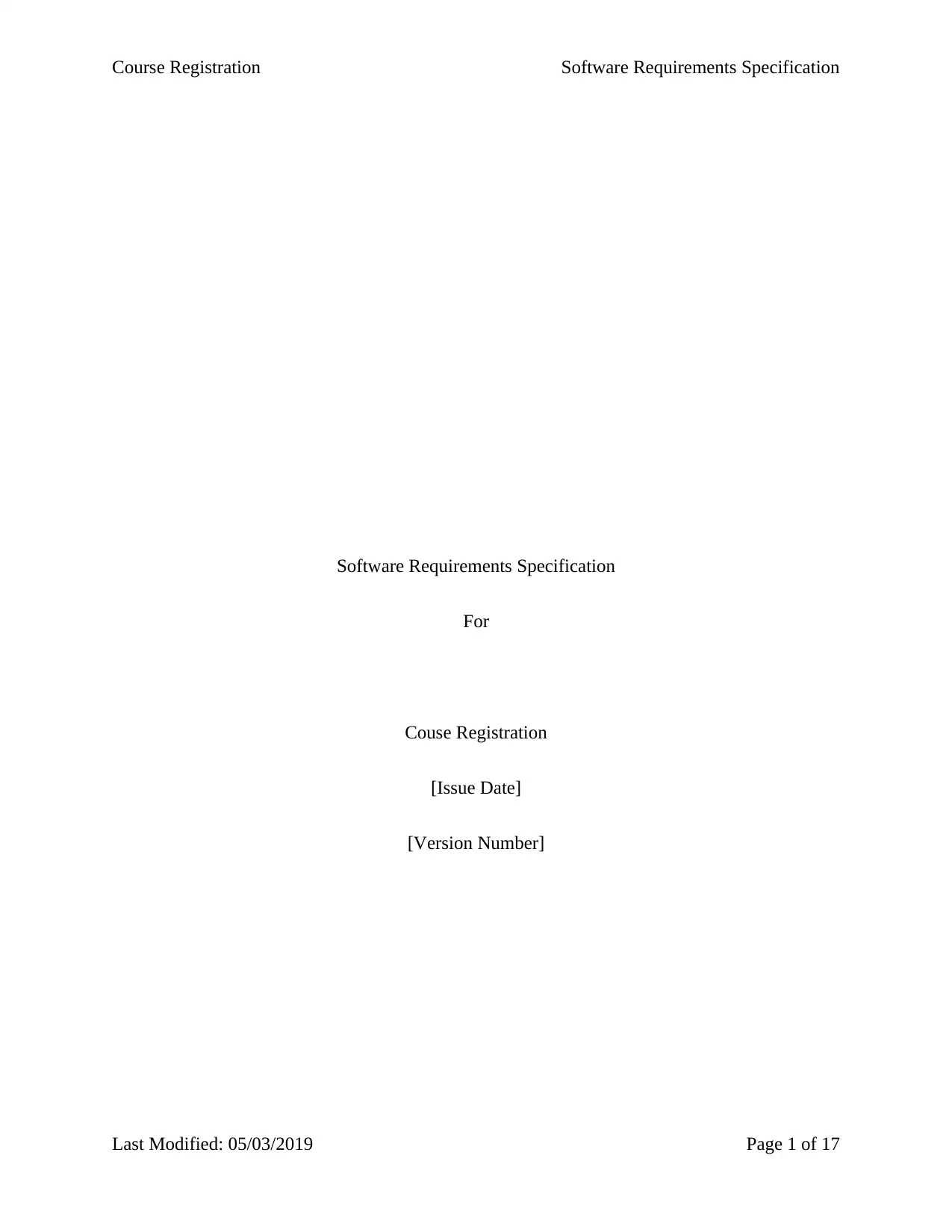
Course Registration Software Requirements Specification
Software Requirements Specification
For
Couse Registration
[Issue Date]
[Version Number]
Last Modified: 05/03/2019 Page 1 of 17
Software Requirements Specification
For
Couse Registration
[Issue Date]
[Version Number]
Last Modified: 05/03/2019 Page 1 of 17
Secure Best Marks with AI Grader
Need help grading? Try our AI Grader for instant feedback on your assignments.
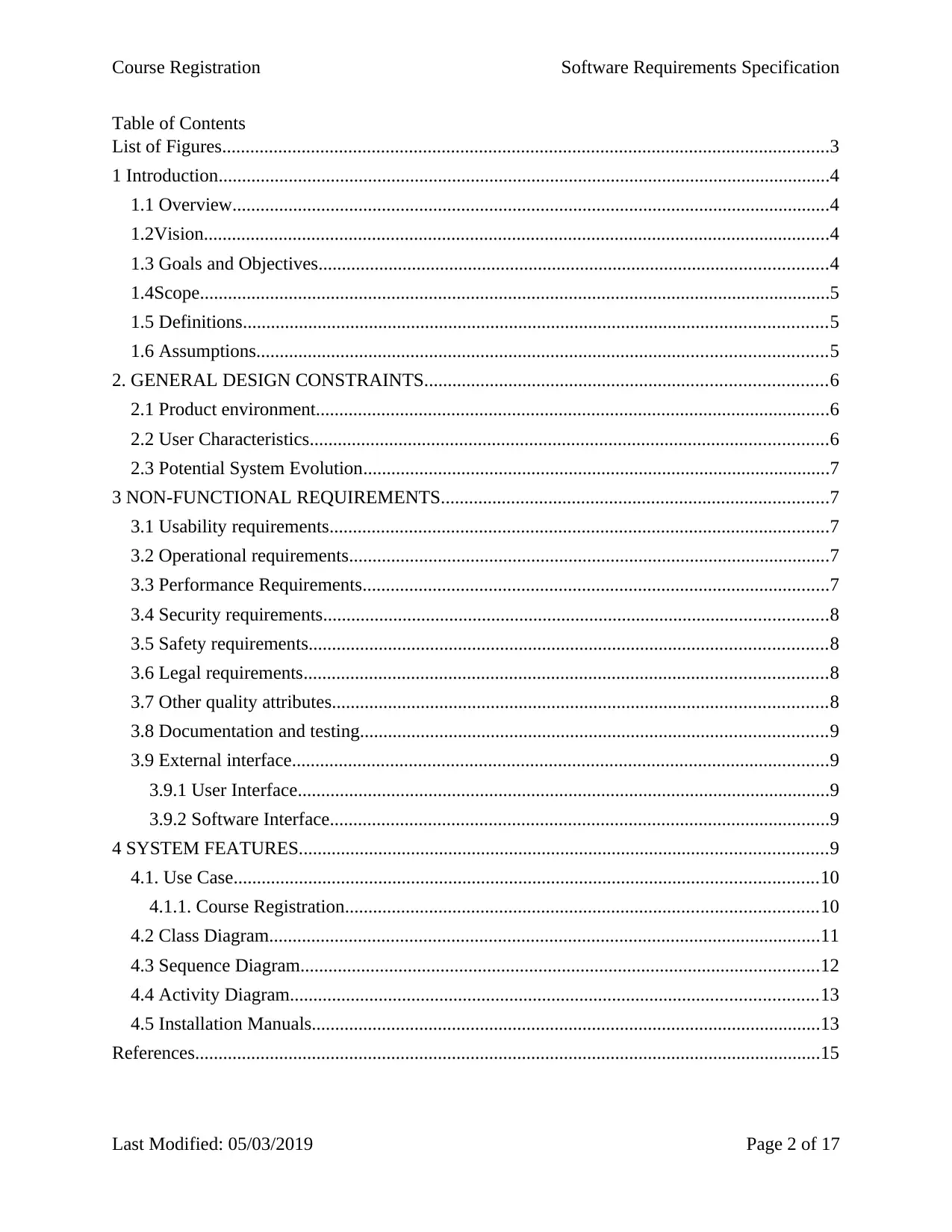
Course Registration Software Requirements Specification
Table of Contents
List of Figures..................................................................................................................................3
1 Introduction...................................................................................................................................4
1.1 Overview................................................................................................................................4
1.2Vision......................................................................................................................................4
1.3 Goals and Objectives.............................................................................................................4
1.4Scope.......................................................................................................................................5
1.5 Definitions.............................................................................................................................5
1.6 Assumptions..........................................................................................................................5
2. GENERAL DESIGN CONSTRAINTS......................................................................................6
2.1 Product environment..............................................................................................................6
2.2 User Characteristics...............................................................................................................6
2.3 Potential System Evolution....................................................................................................7
3 NON-FUNCTIONAL REQUIREMENTS...................................................................................7
3.1 Usability requirements...........................................................................................................7
3.2 Operational requirements.......................................................................................................7
3.3 Performance Requirements....................................................................................................7
3.4 Security requirements............................................................................................................8
3.5 Safety requirements...............................................................................................................8
3.6 Legal requirements................................................................................................................8
3.7 Other quality attributes..........................................................................................................8
3.8 Documentation and testing....................................................................................................9
3.9 External interface...................................................................................................................9
3.9.1 User Interface..................................................................................................................9
3.9.2 Software Interface...........................................................................................................9
4 SYSTEM FEATURES.................................................................................................................9
4.1. Use Case.............................................................................................................................10
4.1.1. Course Registration.....................................................................................................10
4.2 Class Diagram......................................................................................................................11
4.3 Sequence Diagram...............................................................................................................12
4.4 Activity Diagram.................................................................................................................13
4.5 Installation Manuals.............................................................................................................13
References......................................................................................................................................15
Last Modified: 05/03/2019 Page 2 of 17
Table of Contents
List of Figures..................................................................................................................................3
1 Introduction...................................................................................................................................4
1.1 Overview................................................................................................................................4
1.2Vision......................................................................................................................................4
1.3 Goals and Objectives.............................................................................................................4
1.4Scope.......................................................................................................................................5
1.5 Definitions.............................................................................................................................5
1.6 Assumptions..........................................................................................................................5
2. GENERAL DESIGN CONSTRAINTS......................................................................................6
2.1 Product environment..............................................................................................................6
2.2 User Characteristics...............................................................................................................6
2.3 Potential System Evolution....................................................................................................7
3 NON-FUNCTIONAL REQUIREMENTS...................................................................................7
3.1 Usability requirements...........................................................................................................7
3.2 Operational requirements.......................................................................................................7
3.3 Performance Requirements....................................................................................................7
3.4 Security requirements............................................................................................................8
3.5 Safety requirements...............................................................................................................8
3.6 Legal requirements................................................................................................................8
3.7 Other quality attributes..........................................................................................................8
3.8 Documentation and testing....................................................................................................9
3.9 External interface...................................................................................................................9
3.9.1 User Interface..................................................................................................................9
3.9.2 Software Interface...........................................................................................................9
4 SYSTEM FEATURES.................................................................................................................9
4.1. Use Case.............................................................................................................................10
4.1.1. Course Registration.....................................................................................................10
4.2 Class Diagram......................................................................................................................11
4.3 Sequence Diagram...............................................................................................................12
4.4 Activity Diagram.................................................................................................................13
4.5 Installation Manuals.............................................................................................................13
References......................................................................................................................................15
Last Modified: 05/03/2019 Page 2 of 17
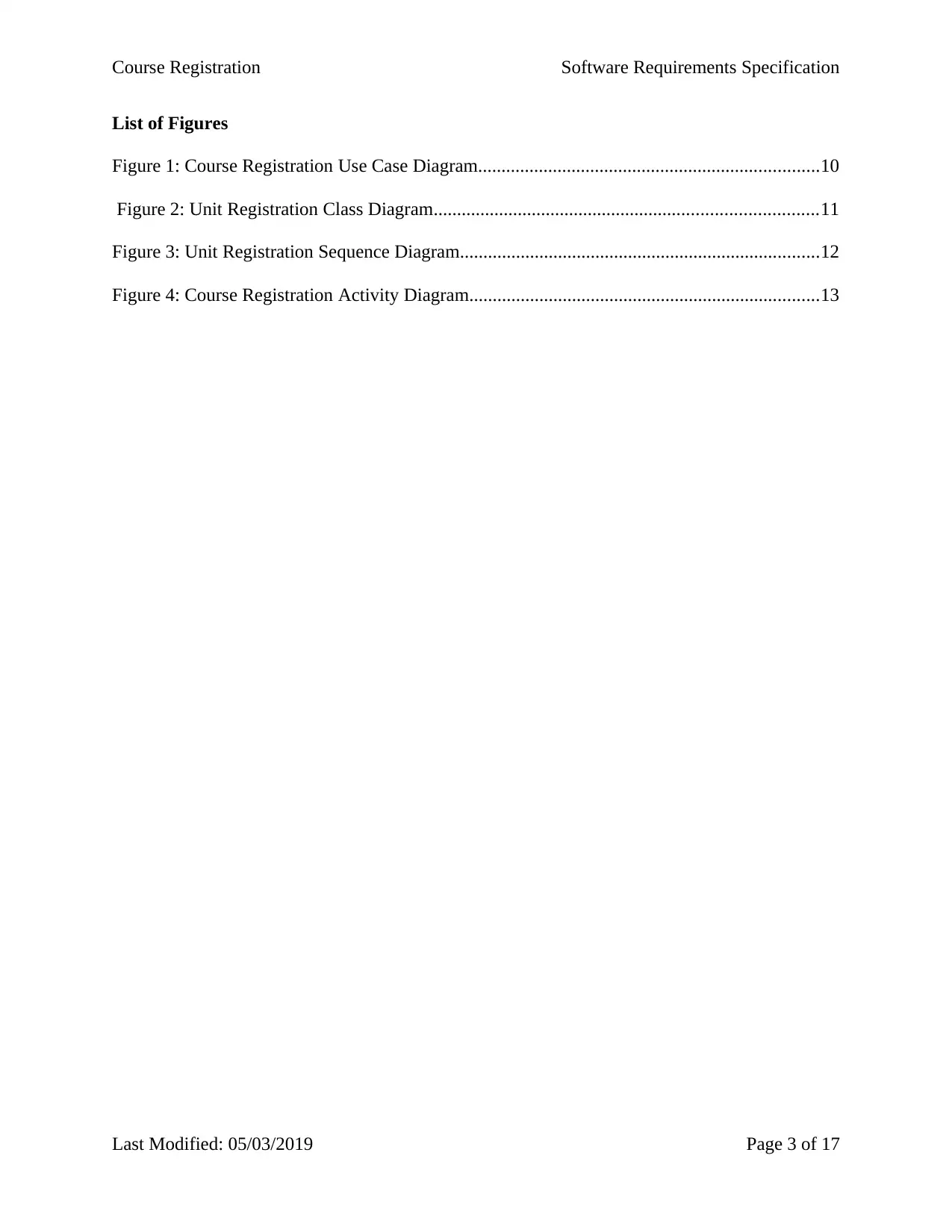
Course Registration Software Requirements Specification
List of Figures
Figure 1: Course Registration Use Case Diagram.........................................................................10
Figure 2: Unit Registration Class Diagram..................................................................................11
Figure 3: Unit Registration Sequence Diagram.............................................................................12
Figure 4: Course Registration Activity Diagram...........................................................................13
Last Modified: 05/03/2019 Page 3 of 17
List of Figures
Figure 1: Course Registration Use Case Diagram.........................................................................10
Figure 2: Unit Registration Class Diagram..................................................................................11
Figure 3: Unit Registration Sequence Diagram.............................................................................12
Figure 4: Course Registration Activity Diagram...........................................................................13
Last Modified: 05/03/2019 Page 3 of 17
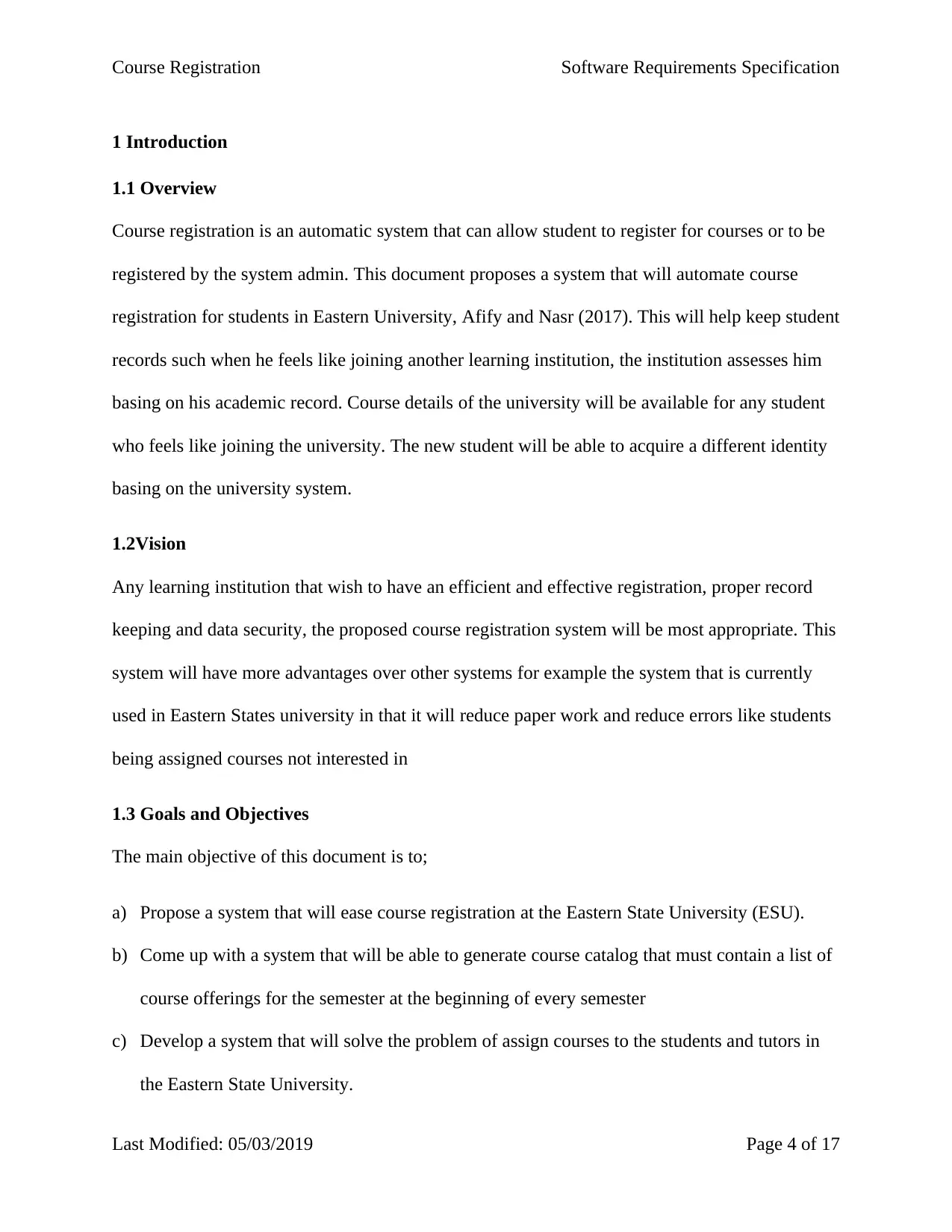
Course Registration Software Requirements Specification
1 Introduction
1.1 Overview
Course registration is an automatic system that can allow student to register for courses or to be
registered by the system admin. This document proposes a system that will automate course
registration for students in Eastern University, Afify and Nasr (2017). This will help keep student
records such when he feels like joining another learning institution, the institution assesses him
basing on his academic record. Course details of the university will be available for any student
who feels like joining the university. The new student will be able to acquire a different identity
basing on the university system.
1.2Vision
Any learning institution that wish to have an efficient and effective registration, proper record
keeping and data security, the proposed course registration system will be most appropriate. This
system will have more advantages over other systems for example the system that is currently
used in Eastern States university in that it will reduce paper work and reduce errors like students
being assigned courses not interested in
1.3 Goals and Objectives
The main objective of this document is to;
a) Propose a system that will ease course registration at the Eastern State University (ESU).
b) Come up with a system that will be able to generate course catalog that must contain a list of
course offerings for the semester at the beginning of every semester
c) Develop a system that will solve the problem of assign courses to the students and tutors in
the Eastern State University.
Last Modified: 05/03/2019 Page 4 of 17
1 Introduction
1.1 Overview
Course registration is an automatic system that can allow student to register for courses or to be
registered by the system admin. This document proposes a system that will automate course
registration for students in Eastern University, Afify and Nasr (2017). This will help keep student
records such when he feels like joining another learning institution, the institution assesses him
basing on his academic record. Course details of the university will be available for any student
who feels like joining the university. The new student will be able to acquire a different identity
basing on the university system.
1.2Vision
Any learning institution that wish to have an efficient and effective registration, proper record
keeping and data security, the proposed course registration system will be most appropriate. This
system will have more advantages over other systems for example the system that is currently
used in Eastern States university in that it will reduce paper work and reduce errors like students
being assigned courses not interested in
1.3 Goals and Objectives
The main objective of this document is to;
a) Propose a system that will ease course registration at the Eastern State University (ESU).
b) Come up with a system that will be able to generate course catalog that must contain a list of
course offerings for the semester at the beginning of every semester
c) Develop a system that will solve the problem of assign courses to the students and tutors in
the Eastern State University.
Last Modified: 05/03/2019 Page 4 of 17
Secure Best Marks with AI Grader
Need help grading? Try our AI Grader for instant feedback on your assignments.
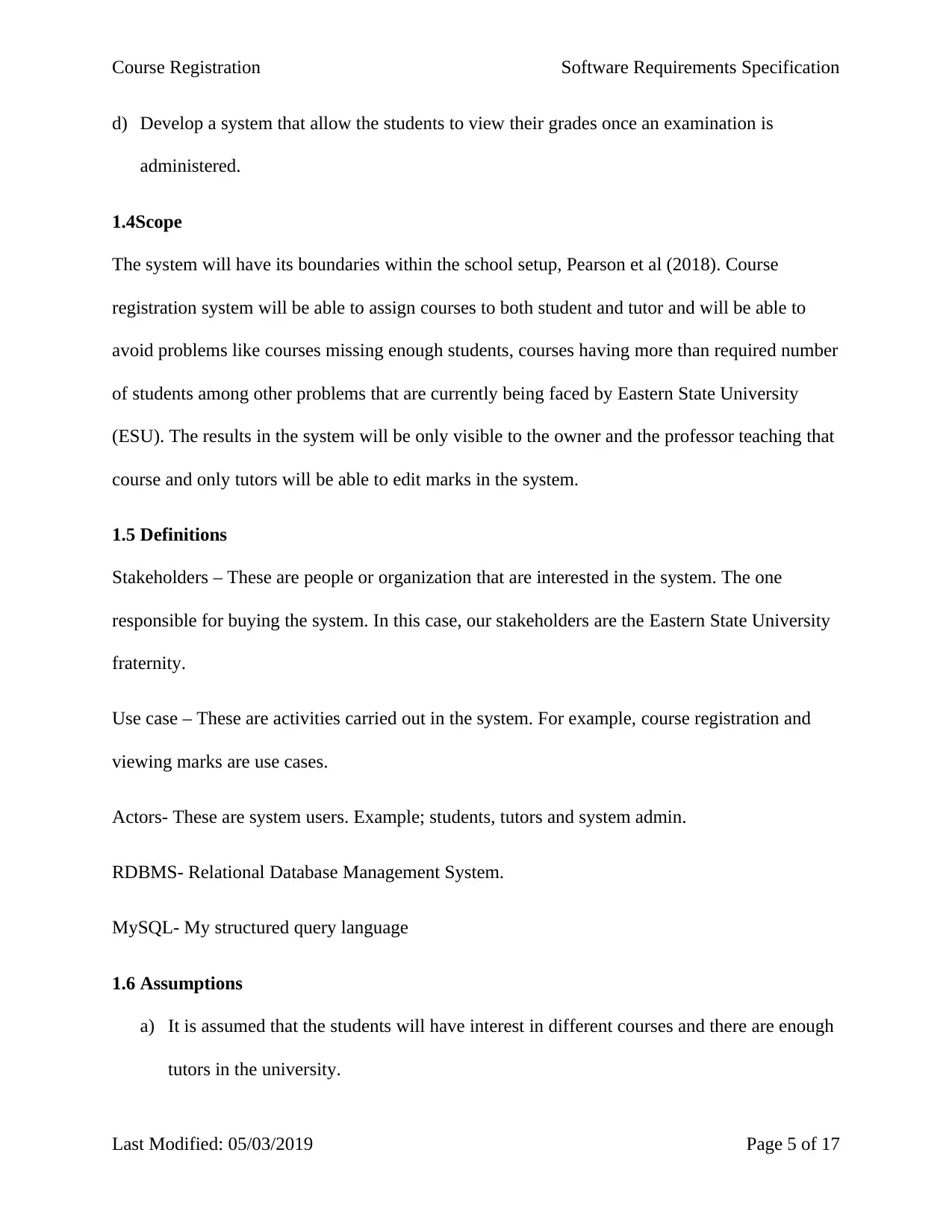
Course Registration Software Requirements Specification
d) Develop a system that allow the students to view their grades once an examination is
administered.
1.4Scope
The system will have its boundaries within the school setup, Pearson et al (2018). Course
registration system will be able to assign courses to both student and tutor and will be able to
avoid problems like courses missing enough students, courses having more than required number
of students among other problems that are currently being faced by Eastern State University
(ESU). The results in the system will be only visible to the owner and the professor teaching that
course and only tutors will be able to edit marks in the system.
1.5 Definitions
Stakeholders – These are people or organization that are interested in the system. The one
responsible for buying the system. In this case, our stakeholders are the Eastern State University
fraternity.
Use case – These are activities carried out in the system. For example, course registration and
viewing marks are use cases.
Actors- These are system users. Example; students, tutors and system admin.
RDBMS- Relational Database Management System.
MySQL- My structured query language
1.6 Assumptions
a) It is assumed that the students will have interest in different courses and there are enough
tutors in the university.
Last Modified: 05/03/2019 Page 5 of 17
d) Develop a system that allow the students to view their grades once an examination is
administered.
1.4Scope
The system will have its boundaries within the school setup, Pearson et al (2018). Course
registration system will be able to assign courses to both student and tutor and will be able to
avoid problems like courses missing enough students, courses having more than required number
of students among other problems that are currently being faced by Eastern State University
(ESU). The results in the system will be only visible to the owner and the professor teaching that
course and only tutors will be able to edit marks in the system.
1.5 Definitions
Stakeholders – These are people or organization that are interested in the system. The one
responsible for buying the system. In this case, our stakeholders are the Eastern State University
fraternity.
Use case – These are activities carried out in the system. For example, course registration and
viewing marks are use cases.
Actors- These are system users. Example; students, tutors and system admin.
RDBMS- Relational Database Management System.
MySQL- My structured query language
1.6 Assumptions
a) It is assumed that the students will have interest in different courses and there are enough
tutors in the university.
Last Modified: 05/03/2019 Page 5 of 17
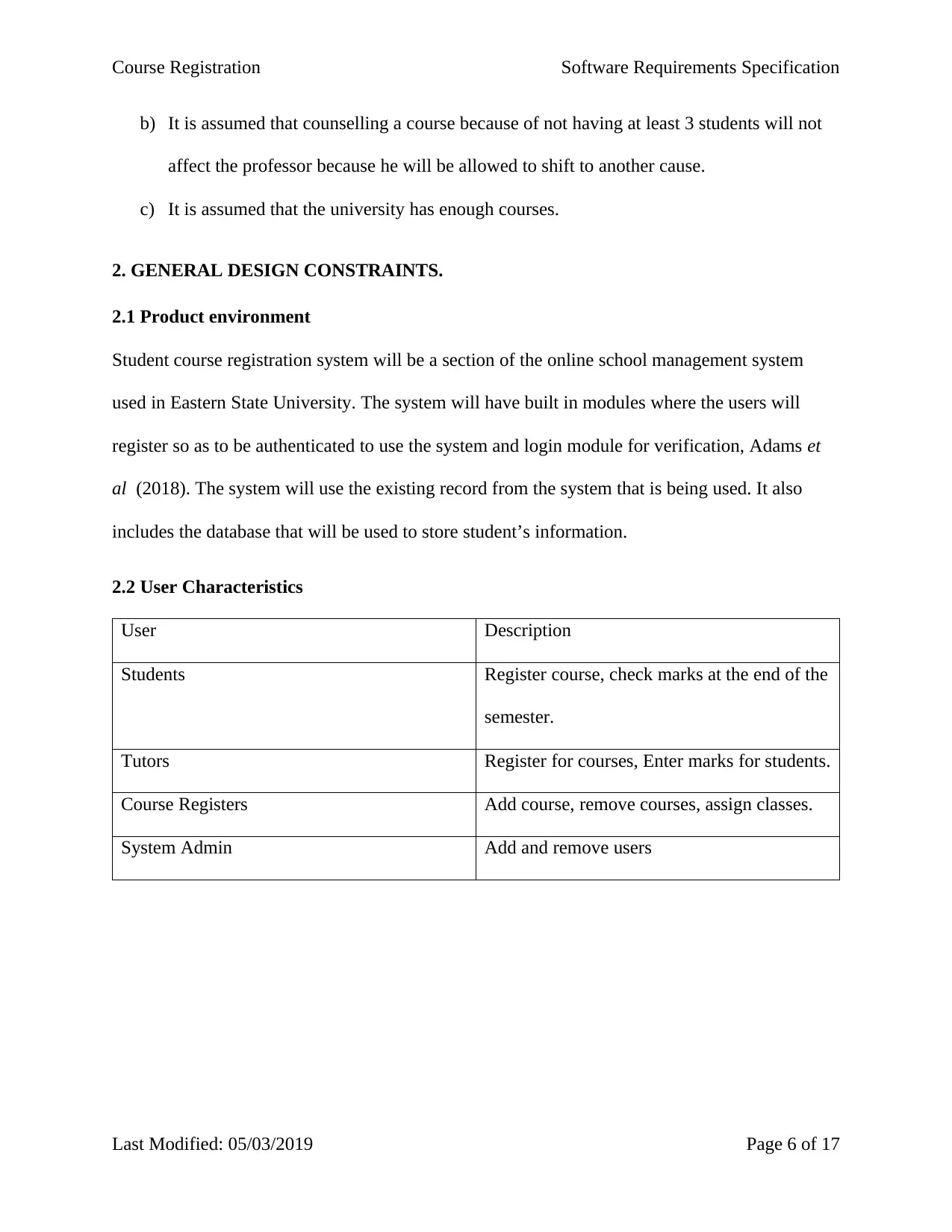
Course Registration Software Requirements Specification
b) It is assumed that counselling a course because of not having at least 3 students will not
affect the professor because he will be allowed to shift to another cause.
c) It is assumed that the university has enough courses.
2. GENERAL DESIGN CONSTRAINTS.
2.1 Product environment
Student course registration system will be a section of the online school management system
used in Eastern State University. The system will have built in modules where the users will
register so as to be authenticated to use the system and login module for verification, Adams et
al (2018). The system will use the existing record from the system that is being used. It also
includes the database that will be used to store student’s information.
2.2 User Characteristics
User Description
Students Register course, check marks at the end of the
semester.
Tutors Register for courses, Enter marks for students.
Course Registers Add course, remove courses, assign classes.
System Admin Add and remove users
Last Modified: 05/03/2019 Page 6 of 17
b) It is assumed that counselling a course because of not having at least 3 students will not
affect the professor because he will be allowed to shift to another cause.
c) It is assumed that the university has enough courses.
2. GENERAL DESIGN CONSTRAINTS.
2.1 Product environment
Student course registration system will be a section of the online school management system
used in Eastern State University. The system will have built in modules where the users will
register so as to be authenticated to use the system and login module for verification, Adams et
al (2018). The system will use the existing record from the system that is being used. It also
includes the database that will be used to store student’s information.
2.2 User Characteristics
User Description
Students Register course, check marks at the end of the
semester.
Tutors Register for courses, Enter marks for students.
Course Registers Add course, remove courses, assign classes.
System Admin Add and remove users
Last Modified: 05/03/2019 Page 6 of 17

Course Registration Software Requirements Specification
2.3 Potential System Evolution
With the increase in the number of users, old data will be backed up elsewhere to create more
space for the newly added information. This will allow scalability function of the system to be
realized.
3 NON-FUNCTIONAL REQUIREMENTS.
There are two kinds of system requirements, functional requirements and non-functional
requirements. Non-functional requirements are all about the operation of the system, Amela et al
(2018). To meet all these requirements, you don’t have to relay on one aspect but diverse
aspects.
3.1 Usability requirements
The system should work effectively and efficiently. The course registration system should work
properly for it to be able to solve the problems faced in the institution.
3.2 Operational requirements
The current course registration system is tiresome as it involves a lot of paper work and has a lot
of weaknesses, the proposed system should be able to minimize or eliminate cases of doing unit
registration manually.
3.3 Performance Requirements
The limiting factor in any organization is time, the proposed course registration system should
not consume a lot of time when being operated. It will be able to use little time possible to
launch.
Last Modified: 05/03/2019 Page 7 of 17
2.3 Potential System Evolution
With the increase in the number of users, old data will be backed up elsewhere to create more
space for the newly added information. This will allow scalability function of the system to be
realized.
3 NON-FUNCTIONAL REQUIREMENTS.
There are two kinds of system requirements, functional requirements and non-functional
requirements. Non-functional requirements are all about the operation of the system, Amela et al
(2018). To meet all these requirements, you don’t have to relay on one aspect but diverse
aspects.
3.1 Usability requirements
The system should work effectively and efficiently. The course registration system should work
properly for it to be able to solve the problems faced in the institution.
3.2 Operational requirements
The current course registration system is tiresome as it involves a lot of paper work and has a lot
of weaknesses, the proposed system should be able to minimize or eliminate cases of doing unit
registration manually.
3.3 Performance Requirements
The limiting factor in any organization is time, the proposed course registration system should
not consume a lot of time when being operated. It will be able to use little time possible to
launch.
Last Modified: 05/03/2019 Page 7 of 17
Paraphrase This Document
Need a fresh take? Get an instant paraphrase of this document with our AI Paraphraser
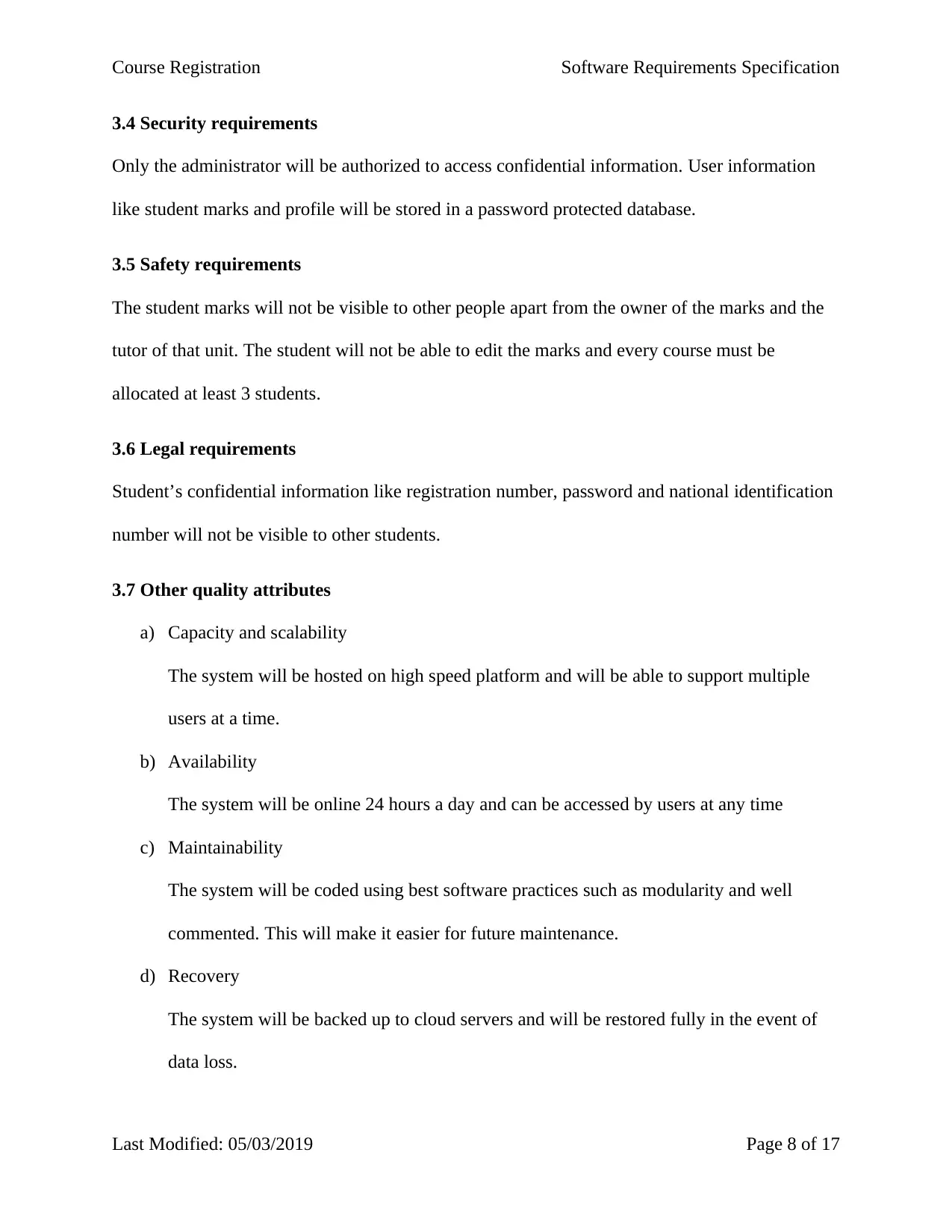
Course Registration Software Requirements Specification
3.4 Security requirements
Only the administrator will be authorized to access confidential information. User information
like student marks and profile will be stored in a password protected database.
3.5 Safety requirements
The student marks will not be visible to other people apart from the owner of the marks and the
tutor of that unit. The student will not be able to edit the marks and every course must be
allocated at least 3 students.
3.6 Legal requirements
Student’s confidential information like registration number, password and national identification
number will not be visible to other students.
3.7 Other quality attributes
a) Capacity and scalability
The system will be hosted on high speed platform and will be able to support multiple
users at a time.
b) Availability
The system will be online 24 hours a day and can be accessed by users at any time
c) Maintainability
The system will be coded using best software practices such as modularity and well
commented. This will make it easier for future maintenance.
d) Recovery
The system will be backed up to cloud servers and will be restored fully in the event of
data loss.
Last Modified: 05/03/2019 Page 8 of 17
3.4 Security requirements
Only the administrator will be authorized to access confidential information. User information
like student marks and profile will be stored in a password protected database.
3.5 Safety requirements
The student marks will not be visible to other people apart from the owner of the marks and the
tutor of that unit. The student will not be able to edit the marks and every course must be
allocated at least 3 students.
3.6 Legal requirements
Student’s confidential information like registration number, password and national identification
number will not be visible to other students.
3.7 Other quality attributes
a) Capacity and scalability
The system will be hosted on high speed platform and will be able to support multiple
users at a time.
b) Availability
The system will be online 24 hours a day and can be accessed by users at any time
c) Maintainability
The system will be coded using best software practices such as modularity and well
commented. This will make it easier for future maintenance.
d) Recovery
The system will be backed up to cloud servers and will be restored fully in the event of
data loss.
Last Modified: 05/03/2019 Page 8 of 17
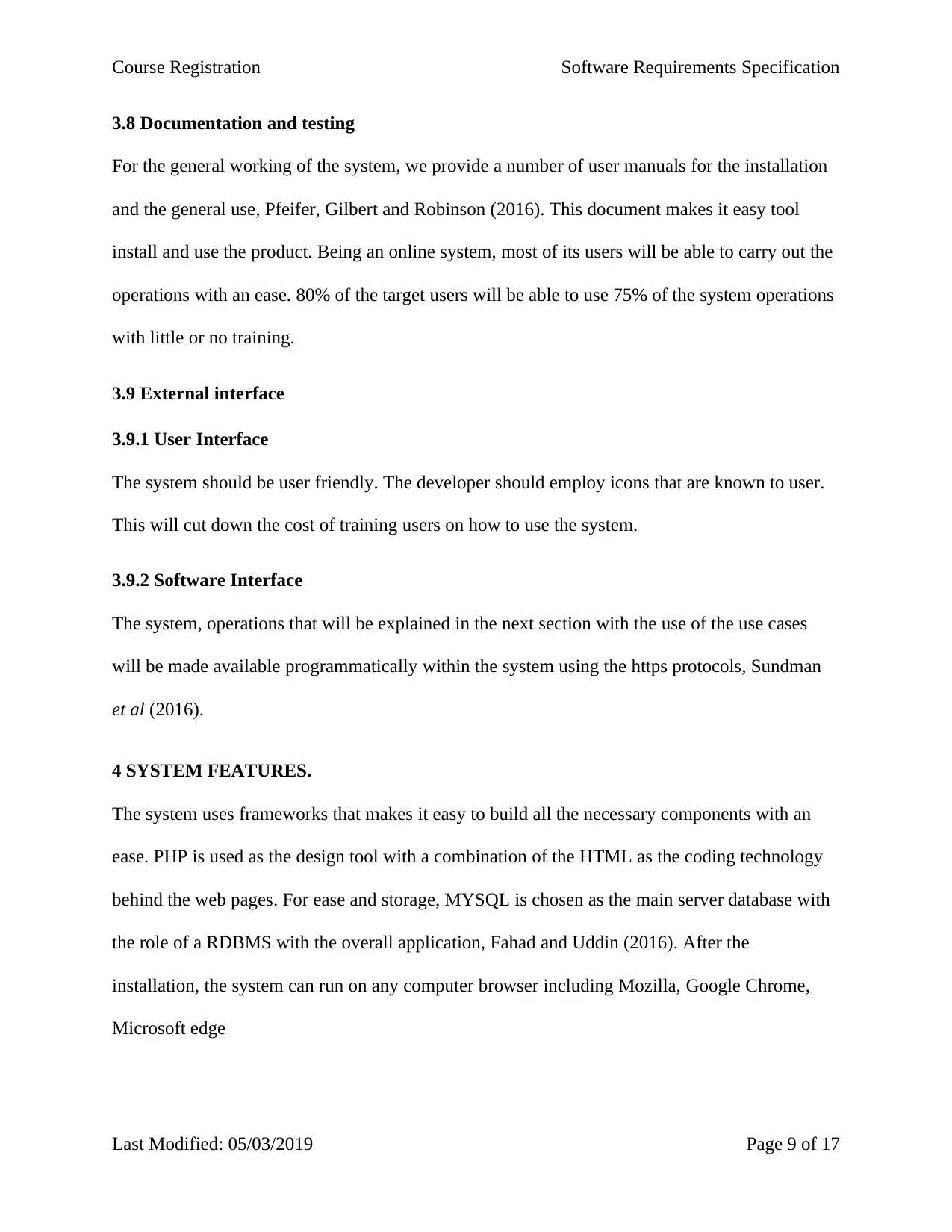
Course Registration Software Requirements Specification
3.8 Documentation and testing
For the general working of the system, we provide a number of user manuals for the installation
and the general use, Pfeifer, Gilbert and Robinson (2016). This document makes it easy tool
install and use the product. Being an online system, most of its users will be able to carry out the
operations with an ease. 80% of the target users will be able to use 75% of the system operations
with little or no training.
3.9 External interface
3.9.1 User Interface
The system should be user friendly. The developer should employ icons that are known to user.
This will cut down the cost of training users on how to use the system.
3.9.2 Software Interface
The system, operations that will be explained in the next section with the use of the use cases
will be made available programmatically within the system using the https protocols, Sundman
et al (2016).
4 SYSTEM FEATURES.
The system uses frameworks that makes it easy to build all the necessary components with an
ease. PHP is used as the design tool with a combination of the HTML as the coding technology
behind the web pages. For ease and storage, MYSQL is chosen as the main server database with
the role of a RDBMS with the overall application, Fahad and Uddin (2016). After the
installation, the system can run on any computer browser including Mozilla, Google Chrome,
Microsoft edge
Last Modified: 05/03/2019 Page 9 of 17
3.8 Documentation and testing
For the general working of the system, we provide a number of user manuals for the installation
and the general use, Pfeifer, Gilbert and Robinson (2016). This document makes it easy tool
install and use the product. Being an online system, most of its users will be able to carry out the
operations with an ease. 80% of the target users will be able to use 75% of the system operations
with little or no training.
3.9 External interface
3.9.1 User Interface
The system should be user friendly. The developer should employ icons that are known to user.
This will cut down the cost of training users on how to use the system.
3.9.2 Software Interface
The system, operations that will be explained in the next section with the use of the use cases
will be made available programmatically within the system using the https protocols, Sundman
et al (2016).
4 SYSTEM FEATURES.
The system uses frameworks that makes it easy to build all the necessary components with an
ease. PHP is used as the design tool with a combination of the HTML as the coding technology
behind the web pages. For ease and storage, MYSQL is chosen as the main server database with
the role of a RDBMS with the overall application, Fahad and Uddin (2016). After the
installation, the system can run on any computer browser including Mozilla, Google Chrome,
Microsoft edge
Last Modified: 05/03/2019 Page 9 of 17

Course Registration Software Requirements Specification
4.1. Use Case
4.1.1. Course Registration
Figure 1: Course Registration Use Case Diagram.
This use case diagram shows all the activities involved in the online course registration and the
people involved. Once the system admin has activated the system at the beginning of the
semester, the registrar adds new courses, students register for courses and they pay for the
courses. The professors also check for the courses assigned after logging in to the system.
Last Modified: 05/03/2019 Page 10 of 17
4.1. Use Case
4.1.1. Course Registration
Figure 1: Course Registration Use Case Diagram.
This use case diagram shows all the activities involved in the online course registration and the
people involved. Once the system admin has activated the system at the beginning of the
semester, the registrar adds new courses, students register for courses and they pay for the
courses. The professors also check for the courses assigned after logging in to the system.
Last Modified: 05/03/2019 Page 10 of 17
Secure Best Marks with AI Grader
Need help grading? Try our AI Grader for instant feedback on your assignments.
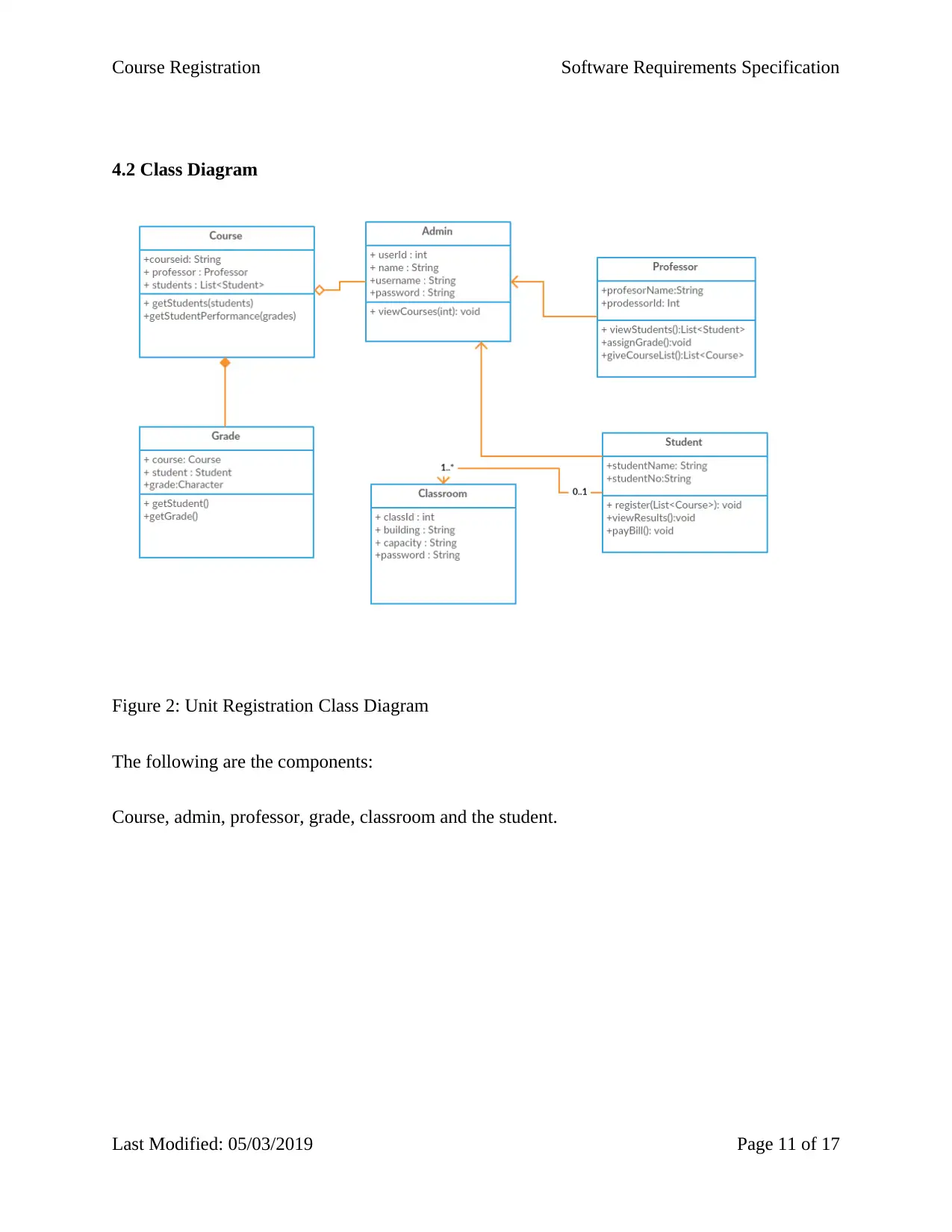
Course Registration Software Requirements Specification
4.2 Class Diagram
Figure 2: Unit Registration Class Diagram
The following are the components:
Course, admin, professor, grade, classroom and the student.
Last Modified: 05/03/2019 Page 11 of 17
4.2 Class Diagram
Figure 2: Unit Registration Class Diagram
The following are the components:
Course, admin, professor, grade, classroom and the student.
Last Modified: 05/03/2019 Page 11 of 17

Course Registration Software Requirements Specification
4.3 Sequence Diagram
Figure 3: Unit Registration Sequence Diagram
From the above, we see a series of events from the registration to the end process. The process is
initiated by the System admin by activating the system at the beginning of semester until the time
the student will be able to view marks.
Last Modified: 05/03/2019 Page 12 of 17
4.3 Sequence Diagram
Figure 3: Unit Registration Sequence Diagram
From the above, we see a series of events from the registration to the end process. The process is
initiated by the System admin by activating the system at the beginning of semester until the time
the student will be able to view marks.
Last Modified: 05/03/2019 Page 12 of 17
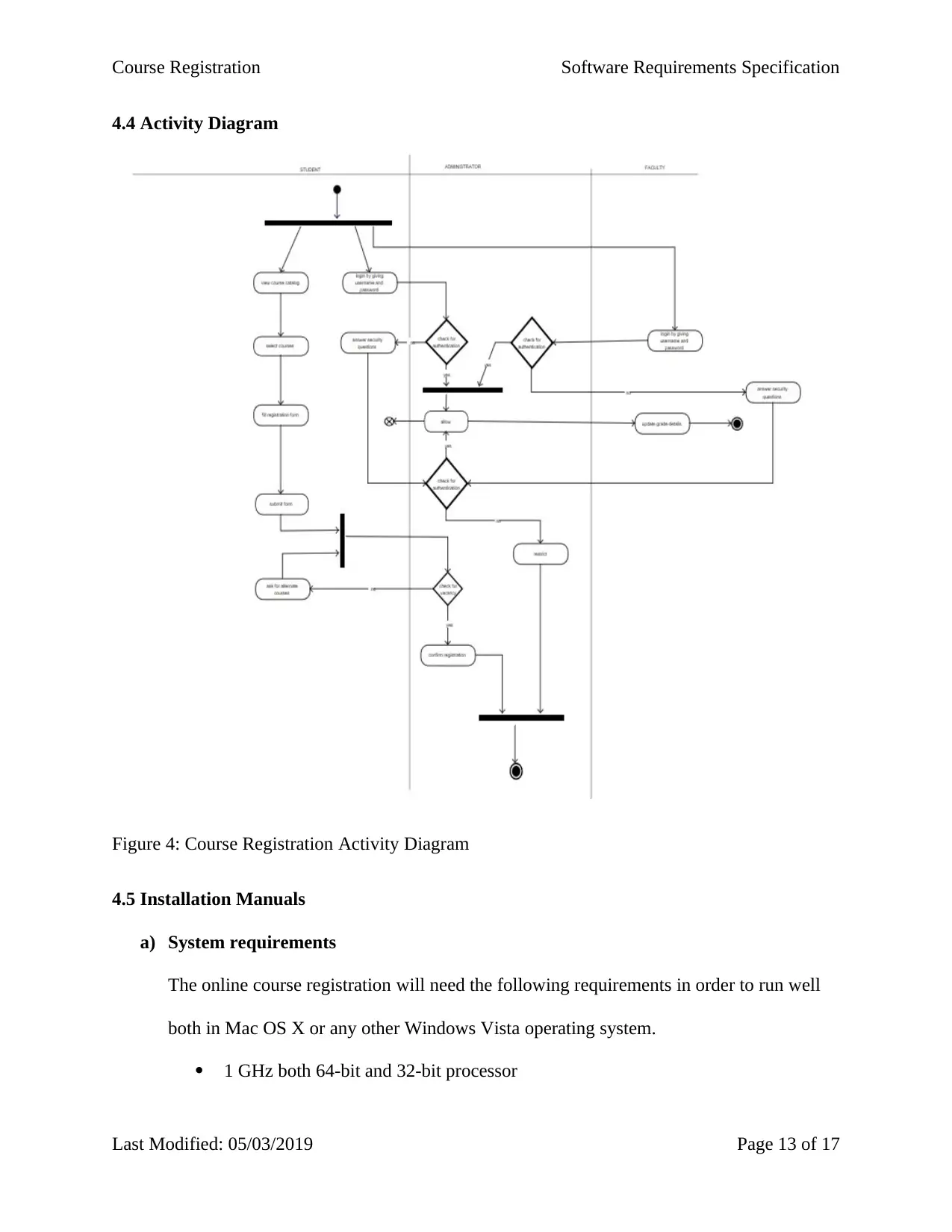
Course Registration Software Requirements Specification
4.4 Activity Diagram
Figure 4: Course Registration Activity Diagram
4.5 Installation Manuals
a) System requirements
The online course registration will need the following requirements in order to run well
both in Mac OS X or any other Windows Vista operating system.
1 GHz both 64-bit and 32-bit processor
Last Modified: 05/03/2019 Page 13 of 17
4.4 Activity Diagram
Figure 4: Course Registration Activity Diagram
4.5 Installation Manuals
a) System requirements
The online course registration will need the following requirements in order to run well
both in Mac OS X or any other Windows Vista operating system.
1 GHz both 64-bit and 32-bit processor
Last Modified: 05/03/2019 Page 13 of 17
Paraphrase This Document
Need a fresh take? Get an instant paraphrase of this document with our AI Paraphraser
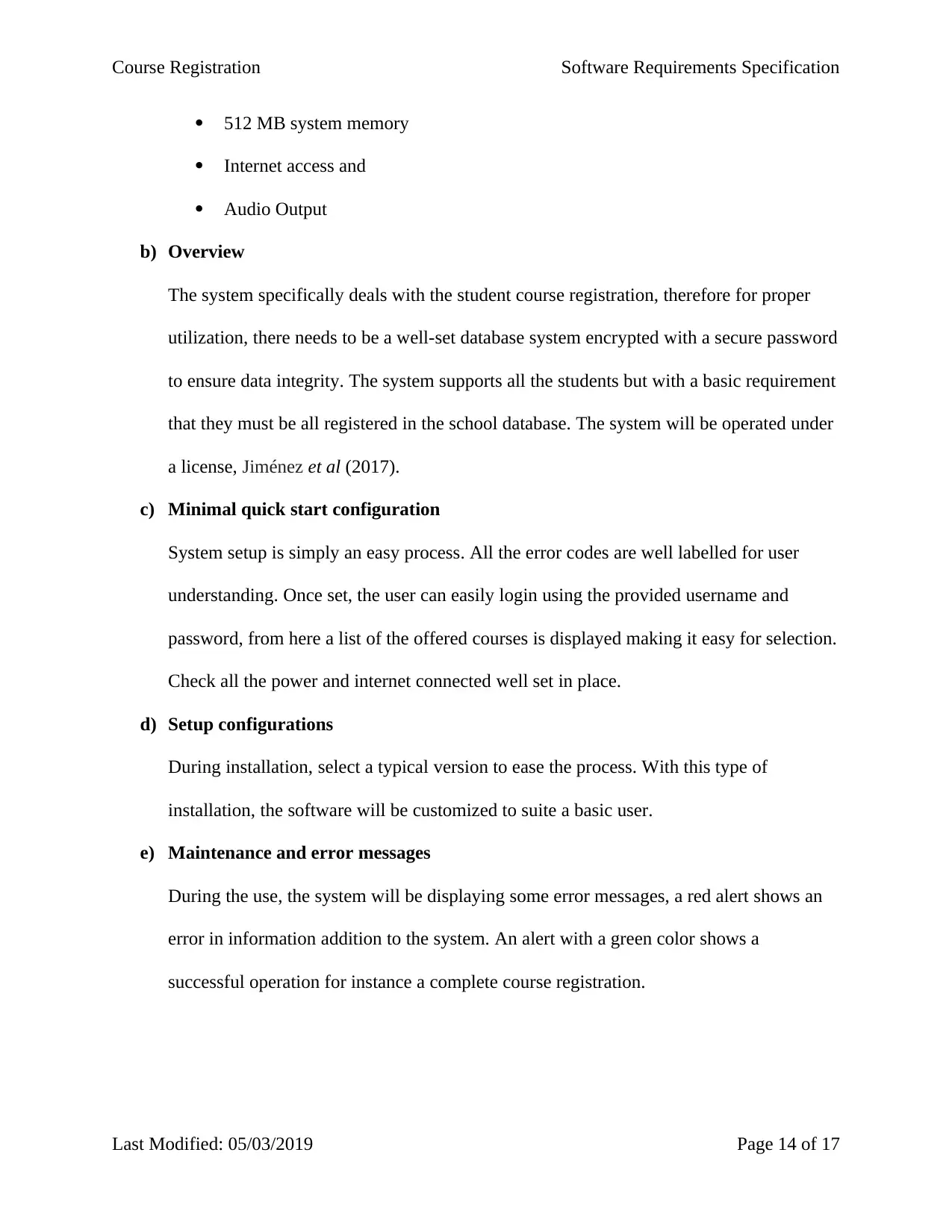
Course Registration Software Requirements Specification
512 MB system memory
Internet access and
Audio Output
b) Overview
The system specifically deals with the student course registration, therefore for proper
utilization, there needs to be a well-set database system encrypted with a secure password
to ensure data integrity. The system supports all the students but with a basic requirement
that they must be all registered in the school database. The system will be operated under
a license, Jiménez et al (2017).
c) Minimal quick start configuration
System setup is simply an easy process. All the error codes are well labelled for user
understanding. Once set, the user can easily login using the provided username and
password, from here a list of the offered courses is displayed making it easy for selection.
Check all the power and internet connected well set in place.
d) Setup configurations
During installation, select a typical version to ease the process. With this type of
installation, the software will be customized to suite a basic user.
e) Maintenance and error messages
During the use, the system will be displaying some error messages, a red alert shows an
error in information addition to the system. An alert with a green color shows a
successful operation for instance a complete course registration.
Last Modified: 05/03/2019 Page 14 of 17
512 MB system memory
Internet access and
Audio Output
b) Overview
The system specifically deals with the student course registration, therefore for proper
utilization, there needs to be a well-set database system encrypted with a secure password
to ensure data integrity. The system supports all the students but with a basic requirement
that they must be all registered in the school database. The system will be operated under
a license, Jiménez et al (2017).
c) Minimal quick start configuration
System setup is simply an easy process. All the error codes are well labelled for user
understanding. Once set, the user can easily login using the provided username and
password, from here a list of the offered courses is displayed making it easy for selection.
Check all the power and internet connected well set in place.
d) Setup configurations
During installation, select a typical version to ease the process. With this type of
installation, the software will be customized to suite a basic user.
e) Maintenance and error messages
During the use, the system will be displaying some error messages, a red alert shows an
error in information addition to the system. An alert with a green color shows a
successful operation for instance a complete course registration.
Last Modified: 05/03/2019 Page 14 of 17
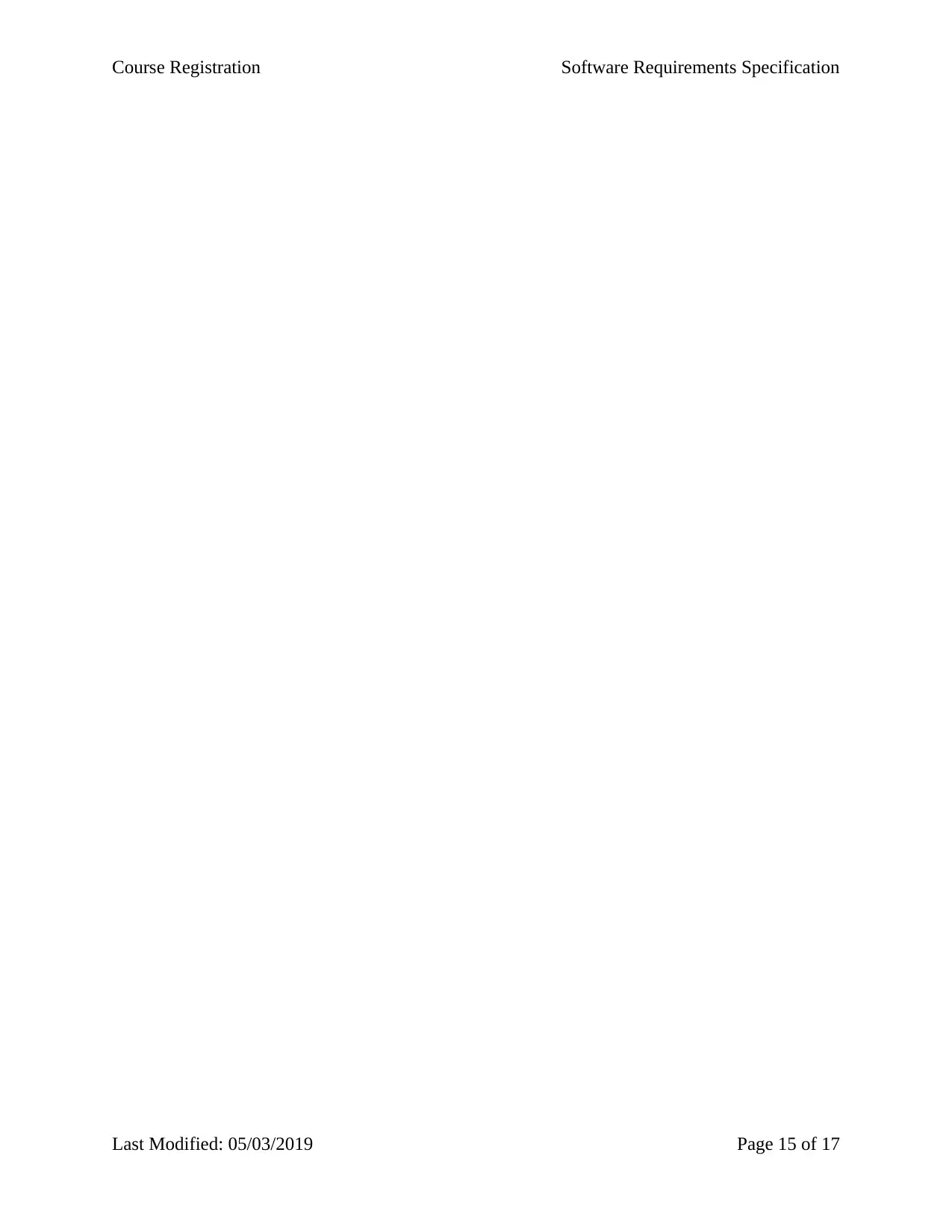
Course Registration Software Requirements Specification
Last Modified: 05/03/2019 Page 15 of 17
Last Modified: 05/03/2019 Page 15 of 17
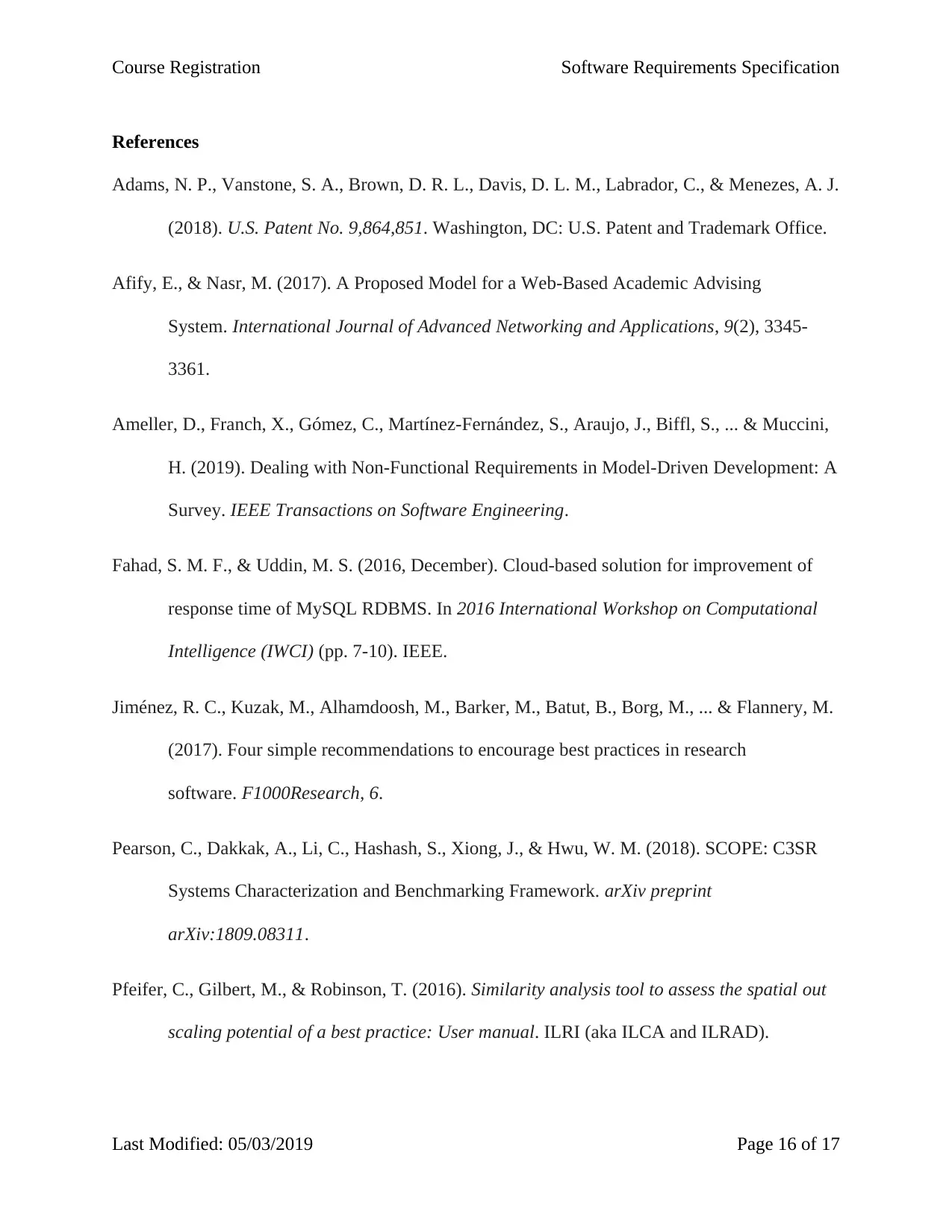
Course Registration Software Requirements Specification
References
Adams, N. P., Vanstone, S. A., Brown, D. R. L., Davis, D. L. M., Labrador, C., & Menezes, A. J.
(2018). U.S. Patent No. 9,864,851. Washington, DC: U.S. Patent and Trademark Office.
Afify, E., & Nasr, M. (2017). A Proposed Model for a Web-Based Academic Advising
System. International Journal of Advanced Networking and Applications, 9(2), 3345-
3361.
Ameller, D., Franch, X., Gómez, C., Martínez-Fernández, S., Araujo, J., Biffl, S., ... & Muccini,
H. (2019). Dealing with Non-Functional Requirements in Model-Driven Development: A
Survey. IEEE Transactions on Software Engineering.
Fahad, S. M. F., & Uddin, M. S. (2016, December). Cloud-based solution for improvement of
response time of MySQL RDBMS. In 2016 International Workshop on Computational
Intelligence (IWCI) (pp. 7-10). IEEE.
Jiménez, R. C., Kuzak, M., Alhamdoosh, M., Barker, M., Batut, B., Borg, M., ... & Flannery, M.
(2017). Four simple recommendations to encourage best practices in research
software. F1000Research, 6.
Pearson, C., Dakkak, A., Li, C., Hashash, S., Xiong, J., & Hwu, W. M. (2018). SCOPE: C3SR
Systems Characterization and Benchmarking Framework. arXiv preprint
arXiv:1809.08311.
Pfeifer, C., Gilbert, M., & Robinson, T. (2016). Similarity analysis tool to assess the spatial out
scaling potential of a best practice: User manual. ILRI (aka ILCA and ILRAD).
Last Modified: 05/03/2019 Page 16 of 17
References
Adams, N. P., Vanstone, S. A., Brown, D. R. L., Davis, D. L. M., Labrador, C., & Menezes, A. J.
(2018). U.S. Patent No. 9,864,851. Washington, DC: U.S. Patent and Trademark Office.
Afify, E., & Nasr, M. (2017). A Proposed Model for a Web-Based Academic Advising
System. International Journal of Advanced Networking and Applications, 9(2), 3345-
3361.
Ameller, D., Franch, X., Gómez, C., Martínez-Fernández, S., Araujo, J., Biffl, S., ... & Muccini,
H. (2019). Dealing with Non-Functional Requirements in Model-Driven Development: A
Survey. IEEE Transactions on Software Engineering.
Fahad, S. M. F., & Uddin, M. S. (2016, December). Cloud-based solution for improvement of
response time of MySQL RDBMS. In 2016 International Workshop on Computational
Intelligence (IWCI) (pp. 7-10). IEEE.
Jiménez, R. C., Kuzak, M., Alhamdoosh, M., Barker, M., Batut, B., Borg, M., ... & Flannery, M.
(2017). Four simple recommendations to encourage best practices in research
software. F1000Research, 6.
Pearson, C., Dakkak, A., Li, C., Hashash, S., Xiong, J., & Hwu, W. M. (2018). SCOPE: C3SR
Systems Characterization and Benchmarking Framework. arXiv preprint
arXiv:1809.08311.
Pfeifer, C., Gilbert, M., & Robinson, T. (2016). Similarity analysis tool to assess the spatial out
scaling potential of a best practice: User manual. ILRI (aka ILCA and ILRAD).
Last Modified: 05/03/2019 Page 16 of 17
Secure Best Marks with AI Grader
Need help grading? Try our AI Grader for instant feedback on your assignments.
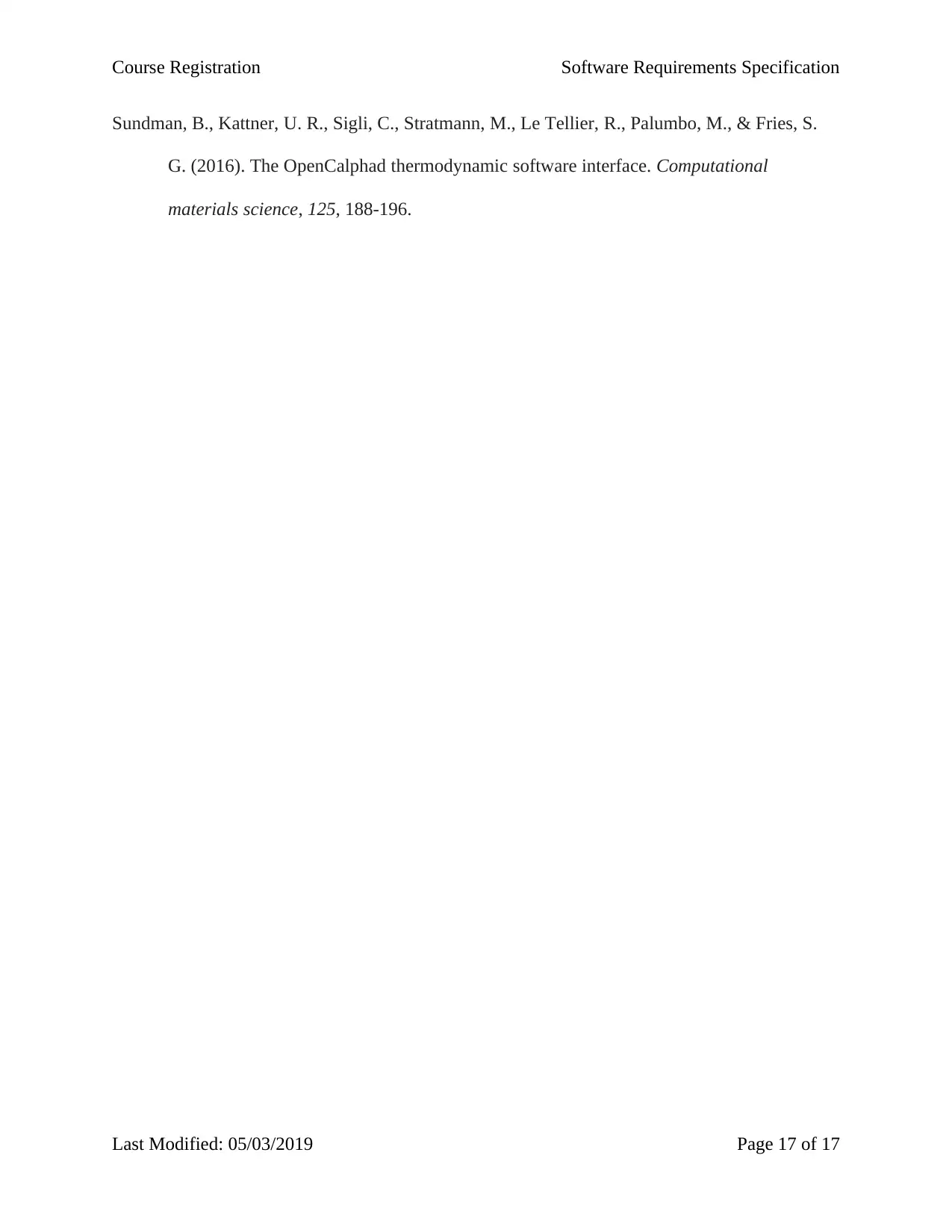
Course Registration Software Requirements Specification
Sundman, B., Kattner, U. R., Sigli, C., Stratmann, M., Le Tellier, R., Palumbo, M., & Fries, S.
G. (2016). The OpenCalphad thermodynamic software interface. Computational
materials science, 125, 188-196.
Last Modified: 05/03/2019 Page 17 of 17
Sundman, B., Kattner, U. R., Sigli, C., Stratmann, M., Le Tellier, R., Palumbo, M., & Fries, S.
G. (2016). The OpenCalphad thermodynamic software interface. Computational
materials science, 125, 188-196.
Last Modified: 05/03/2019 Page 17 of 17
1 out of 17
Related Documents
Your All-in-One AI-Powered Toolkit for Academic Success.
+13062052269
info@desklib.com
Available 24*7 on WhatsApp / Email
![[object Object]](/_next/static/media/star-bottom.7253800d.svg)
Unlock your academic potential
© 2024 | Zucol Services PVT LTD | All rights reserved.





